Once again I saw this pattern sewn up by another blogger, whose post title encapsulated everything I feel about a good pants or shorts pattern. So slight impulse purchase, I ordered/downloaded the pattern and made up a test sample. I used size 10-12-ish and it fit well, the only change I made after doing the test version was lengthening the back by adding an inch at the top of the center back tapering to zero at the side seams. Almost forgot, I did lengthen by about 3 inches. So they are short.
This fabric is leftover from my self-drafted black denim jacket that I made at the end of last summer (worn a ton). This denim is fab, stretchy, good recovery, kind of a charcoal color. And now I can have a very odd suit if I choose - jacket and shorts. Which I do NOT choose.
Oh yeah, I did welt pockets. Kind of slapped them on there with not a lot of consideration for placement but they don't really show as worn with t-shirts so they are fine.
I used my serger for a change. With wanton disregard for thread color. Like it matters...
But I did take care with the welt pockets because I really don't like it when the lining or other fabric shows through at the welt opening, so I add a bit of the actual fabric on the top of the pocket lining. Like so.
So a straightforward summer project and new pair of very useful shorts.
Now a few thoughts about independent patterns, i.e. not the Big 4, which comprise Vogue, Butterick, McCalls (all one company really), and then Simplicity, which includes New Look also. This does seem a bit of a US-centric description as I think of Burda as equally Big, so perhaps the whole group should be the Big 5.
I'll start with a disclaimer, or at least my impression regarding independent patterns, which is that I am probably not the target market. My real interests in sewing are tailoring, jacket and coat-making, and complex patterns with pleating or draping. These are some of the designer Vogue dress patterns I have made in the past few years. (left to right, Vogue 1117, Vogue 1191, Vogue 1159). Funny they look so similar here but they are quite different.
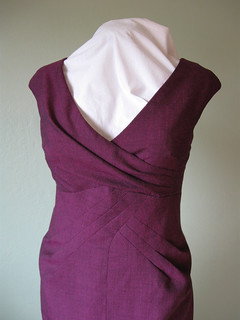
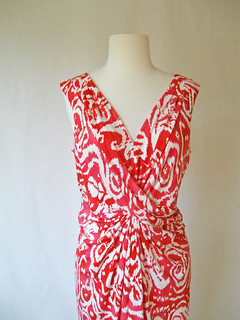

Pattern-wise I am always on the hunt for great coat and jacket patterns, and have had good luck with Burda and Simplicity (as well as Vogue). (left to right Burda jacket, Simplicity 2311 coat, BurdaStyle handbook coat)
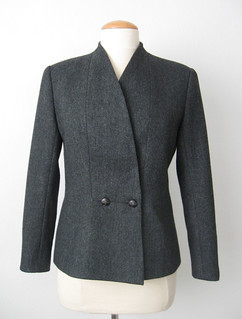

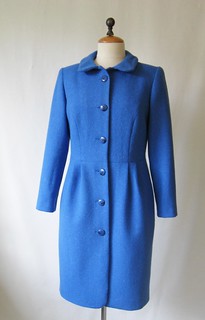
So when I say I am not the target market, my impression is that a lot of the independent pattern companies are focused on sewers who are not been sewing a long time, or want a pattern that includes a comprehensive instructions along with the pattern, possibly also a sew-along to help with the process. There are certainly exceptions, (Sewaholic - some interesting jackets and a coat and there are plenty of other designers that have some unusually styles) although I have noticed that her recent releases are much less complex than the first ones. Don't get me wrong, there is absolutely a place for every level of sewing pattern and type of instruction included. I think it would have been really fun to join in but I learned to sew pre-internet and there was a lot of struggling along with only the instruction sheet to figure things out. However there is a lot of sameness, so many items that to my eye are so similar that it kind of confounds me (this is the business/marketing side talking).
Where there is a big gap in the pattern world is for the plus-size or curvy market. There are a lot of sewers who want to make up the styles shown in an indy pattern but the sizing is not there. (That is such a great name - I have really been enjoying reading the Curvy Sewing Collective posts) I think if I were going to create sewing patterns (which I am not) then for pure sales opportunity that would be a good area to target and design for. With new online groups like the Curvy Sewing Collective the opportunity to connect and have a built-in market is becoming evident. I know there are a few indy patterns/designers in that size range but not enough that if a new brand came along with some good social media marketing and a variety of fit options (like cup size variation, height adjustments etc) they could really give the Big 5 a run for their money.
Getting back to the shorts I made above, the pattern was fine and went together well. As usual I didn't look at the instructions but prior to writing this post I looked through them so I could give some feedback, and to my surprise they said "all seam allowances are 1/2". What? that is unusual. So my feedback on fit is a little off, as I sewed the whole thing at 5/8". Not that it mattered and I probably should have looked before I sewed but 1/2" is kind of an odd choice. Most times when I have encountered a different seam allowance it is 3/8". Jalie, focused on knits, and Petite Plus, both have 3/8" and also are both from Canada which made me think it is more the standard metric seam allowance? in any case 3/8" is actually better for construction but I do like the typical US 5/8" as it allows a good amount of wiggle room for fitting. Anyway - the instructions were OK, nothing particularly different and not really as good as the ones I have seen in a Simplicity or McCalls pants pattern.
Grainline definitely fascinates me as the patterns are far from unique, costly when compared to a Big 5 and only include the one item, with not a lot of variation (not including both pants and shorts in one pattern, or sleeve and collar variations). I heard the designer interviewed on the radio show Marketplace and it was really interesting. She certainly has the background and I hope she develops some more patterns with a bit more complexity or detail as I would like to support the business. I have not tried their woven t-pattern but have been asked by others at various sewing meet ups to diagnose issues with the fit on that pattern Which brings me to my next observation.
Regarding a lot of indy patterns, say what you want about the excessive ease on Big 4 patterns but if a pattern does not appear to fit on the model in the bust and chest then I would be very hesitant to purchase. The bust darts need to be in the right place and be angled properly to get the most flattering fit and look. The shape of the armhole and the sleeve that fits in it is also really critical. Certainly there is fit variation in people, and a new pattern company can develop their own size scale but if there are creases and pulling across the body, or at the shoulders then the pattern looks problematic to me.
Pricing is another factor in non Big 4 patterns. Certainly I am in the US so I can buy Big 4 patterns which have crazy list prices but are on sale between $ 1 - $ 4 just about any week. New Look patterns are always $ 4. Plus there is the value part of the equation, I do like buying patterns that have more than one item. A lot of the Big 4 patterns, particularly for tops, have more than one version in the envelope, sometimes as many as 3 very different versions so that is really getting more for the price. A lot of the Vogue designer patterns which are separates have a top and skirt, or a jacket and pants, possibly with variations so that another way they give you more than a single item for $ 12.
It is a matter of personal taste but I do prefer paper patterns, it is just easier to skip that step of printing, taping and either cutting out an unwieldy taped together thing or tracing from that onto other tracing paper. If I am in need of instant pattern gratification then BurdaStyle downloadable for $ 6 has been very good (wool tweed jacket above was a pdf) and with a bit of searching they have just about any basic style and plenty of interesting ones as well. However if I saw a great pattern and it was PDF only that would not be a deal breaker. Like the Tania culottes, unique and turned out very well, although that is the only pattern in that line that seemed really different from the rest of the marketplace.
As a consumer I also look for really good info on a pattern web site. Technical drawings are SO important. Not stylized, cute drawings, but the standard style of technical drawing. This is really how I am deciding on a pattern so if they are not there, or pop up in a tiny window on my laptop - then they are not going to get a good look from me. The Big 4 and Burda do a good job with these and despite some of the wacky fabrics or poses they show the technical drawings are what sells the patterns.
This post is turning out to be longer than I planned and I have a lot more thoughts on patterns. Does it deserve another post? Let me know. Colette's Laurel - I have helped a few friends with this one and whew, it took a lot of alterations to get it to fit (could have started with a similar New Look or Burda and been done in much less time). Pauline Alice's Alameda dress, so cute, love it with my favorite cut-in armholes. plus it is a skirt/top/dress combo. Maybe next spring. Stepalica patterns, now those are some interesting and complex looks, why have I not made one? I resolve to next year. Lekala patterns have worked out very well for some and not others - but the idea of customized downloadable patterns really is the ultimate in pattern shopping so they deserve more testing.
Last year I was joking with my friend Elizabeth of the Sewn blog and mentioned that I love to pick out patterns, I always want to suggest them to various seamsters I meet either in person or on line. So we decided that I wanted to be a "pattern whisperer". In fact now I have convinced myself to do another post on the basic patterns that are really adaptable, fit-able and easy to sew that I think make a good start for anyone.
Happy Friday and this weekend I am finishing up those "please copy these shorts" for someone in my family that I mentioned in the last post, plus finishing up this year's birthday dress which is a pattern repeat (yeah!) in a slight wacky fabric, not 100% sure about it but what the heck.
Beth
today's garden photo - what else this time of year but tomatoes? Yumm.


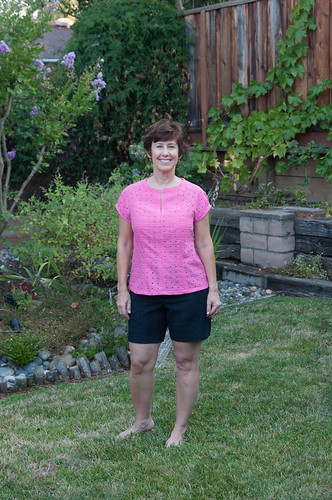
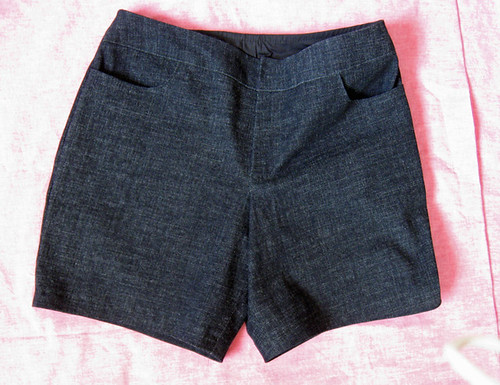
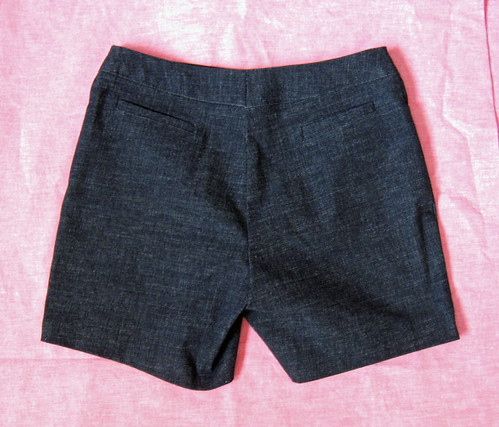
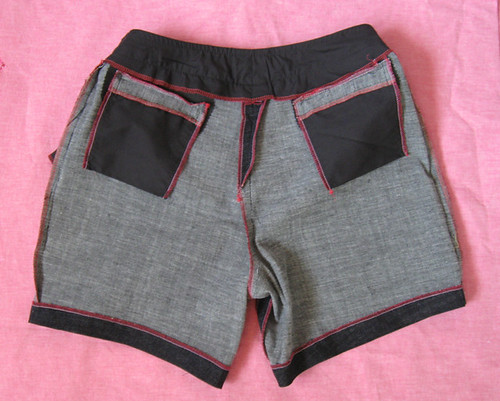
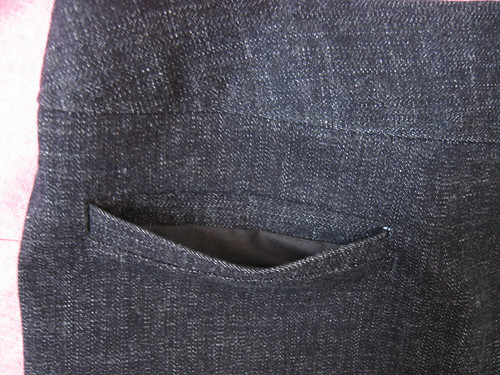






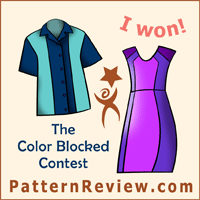



Lots of interesting thoughts! I think the Big 5/Indie debate really comes down to what each of us has experience with, and like you say, what kind of garments we want to make. I'm only a few years into sewing, so for me the bonus of buying indie is that I can talk to the designer on twitter any time I have a question. It also becomes a lot about personality - once you read an indie designers blog, talk to them through comments, tweet, IG, etc, there's a personal connection that influences buying their pattern over a big 4. (Also, I'm in Canada, so the BIG 4 patterns aren't a cheap as you find them, and some like SImplicity aren't even sold in my local chain store anymore.)
ReplyDeleteI"m looking forward to you pattern whisperer posts! :)
Hello there Beth, I always enjoy reading thoughtful posts such as these. I have written a little about these issues before too. I learned to sew on Big 5, and although I use Indie patterns as well, I often do so with some reservations. There are indie designers whose patterns I will not ever go near again, and there are others who I am always interested in. I love sewing with StyleARC patterns, but note that because I am in Australia the postage costs are quite acceptable for those. Big 5 patterns are actually very expensive for me to buy (not that it stops me, but I wait for sales or buy them direct from the US and pay the postage). Pdf patterns can be a great option in regards to eliminating postage costs, and because they can be reprinted for different sizes (I sew for both my daughters and am a massive fan of the Oliver + S patterns for every single reason possible including this one). I don't think that I am target market of lots of indie patterns either, and also don't like the lack of options offered in many of the patterns for the price that is charged. Aren't we lucky that we can have the best of both worlds though!
ReplyDeleteAnd if you every want to suggest some patterns to me, I would LOVE it!
Regards, Lara (http://thornberry.wordpress.com)
Ooooh I really liked this post! I appreciate all your insight as you make some really good points. I like to support indy designers, but the price tag per pattern does make me really consider whether I want to buy them. I've found that Sewaholic Patterns require no major alterations for me so I'm partial to them. I really love the Minoru jacket!
ReplyDeleteWhen I first started sewing I was so stumped by the extra ease in the Big 4 patterns. Once I learned how to actually find my size I found them a lot easier to work with. Such a rookie mistake :) I recently bought a McCall's knit top pattern (a Palmer/Plestch design) and was so pleasantly surprised with the intensive pattern alterations instructions. The Simplicity Amazing Fit line of patterns has great instructions, but some of the other Simplicity patterns I've used have sub-par finishes where even my mom took one quick look and accused me of cutting corners, ha! I have yet to try a Vogue pattern, but I really need to get some especially after seeing all of your dresses and coats, which appear to have a higher level of sewing/tailoring, something I'm gradually gravitating towards. Always look forward to your great posts and makes!
You know, the whole extra ease thing still baffles me. Is it really a rookie mistake to compare your measurements to those on the envelope (using high bust if larger than a B cup , etc) and expect the finished ease to be similar to that shown on the envelope? Since the Big 4 patterns are usually 15-30 dollars here, which is a lot to pay to experiment, I've given up on them. Plus I can take a Style Arc pattern and just add for my lumpy bits and it fits as expected. But there are some nice styles in Big 4, so if you have the key to choosing the pattern size please share it!!
DeleteSo how did you find your actual size?
DeleteThank you for sharing your thoughts on patterns, Beth! This is a very interesting post to me. Your sewing is always impeccable and I can see that you care sewing itself very much through your beautiful finished product. Though I'm probably a bit different type of sewist from you, I have many points that I can't agree with you more in this post, like your thoughts on less complexity on newer patterns from many independent pattern companies. I'm Okay with simple patterns, though, I am definitely not a fan of easiness oriented sewing.
ReplyDeleteGreat topic & thanks for sharing your perspective! After having a subscription to Burdastyle for some years, I feel like I must have virtually every pattern under the sun already. What I don't have in that collection can usually be made by adapting one that I do have. I also buy the occasional Vogue or McCalls pattern (BMV sale, of course!)
ReplyDeleteI tend to agree about the target market for the indies. Most indies seem geared towards beginners or those that want/need more support. I would consider myself to be in the broad category of "intermediate." That means that I've been sewing on and off since I was about 8 or 9 years old. I learned from my mother, a home ec major in college, and my grandmother, who had a sewing business and could sew anything. I watched my mom and grandmother make so many things.
Since home ec has largely been dropped from school programs and most people rely on fast fashion these days, I suspect that a lot of familial sewing knowledge has been lost or is just untapped. Many youngish sewers did not grow up in households where most of the family clothes (at least for the girls) was sewn. Probably the extra attention by way of the indie company's tutorials and such is appealing in that context. I think that this additional interaction could be considered as an added value to the pattern, and in that way it could justify the higher cost to the consumer.
For me, I find myself drawn more to learning better skills and trying to figure out my own fit issues. So, the indies don't have much attraction for me personally, but I think that they have inspired many to take up sewing, and at least that is a good thing for the rest of us too. It will be interesting to see what the sewing industry looks like in another 10 or 20 years.
~Jen
I really love the indy pattern company Oliver + S for childrens' wear because they start at such a small size and provide details that the big 4 just usually don't. Not everyone wants to sew big bubble clothes for the little people in their lives, but that is mostly what's available for toddlers. Otherwise I've bought very few over the years that haven't gotten much use - some Hot Patterns and a few Jalie. I do intend to use them, it just takes me forever to get around to it. I'm with you, though. I like fitted and detailed patterns, and Vogue especially is great for that. I don't need detailed directions or sew alongs, so I guess I'm not who those patterns are marketed to either. I'm all for supporting small businesses and the sewing community, but I just can't justify most of those high prices unless the design is really unique. Well, great post! I enjoyed reading your thoughts on the matter.
ReplyDeleteAgree whole heartedly with all your thoughts and the insights of those commenting too. X100
ReplyDeleteI had to chuckle about what you said about Colette's Laurel! I just caved in and purchased the Laurel pattern and have made a Laurel top. I have tinkered with fit and will need to do much more to make it work- and this was a beginner pattern. ( I am no fit genius!) I was looking forward to this post. I hesitate to say that I am not the Indie market either. Which makes me a little sad, because there are some cute patterns. I don't mind making simple garments. I just want makes that are successful. I am an advanced beginner.
ReplyDeleteThat is a really great post!
ReplyDeleteAs an European consumer, the seam allowances always throw me of a bit, I am used to 1cm (have no idea how much it's in inches) and it mskes me guess people's sanity when I see tham attaching collars with 1,5cm or sewing pants seats with the same width. As for the price of indie patterns - to make a pattern is a hard and costly work. The big 4 and Burda are huge companies! Indie patterns are more often a one woman show.
Big companies do everything inhouse, little ones usually pay for some other company to do the grading. Printing is also very costly. hence the bigger price.
As for the size range...there definitely is a big market for plus sizes and I sm keeping my fingers crossed for all the gorgeous curvy ladies out there that in a near future more and more indie patterns will be available in wider size range.
Again, great post, gave me lots to think about!
This is very interesting to me too, Beth! and I enjoyed reading your thoughts so much. I think you and I have a similar background in our sewing journeys I think, learning from the pattern instructions pre internet. I like very intriguing and different patterns particularly the Vogue designers which are the most interesting out of the Big4 in my opinion, but it's also good to have some plain and simple to make basics and for customising too and it's lots of fun to experiment with new cutting and draping concepts like those in Japanese pattern books, which I love.
ReplyDeleteRegarding fit; well for me, Burda, both envelope and magazine patterns, have the best fit straight off the bat out of all of them. It would be really very interesting to see or read an article about the different blocks used by the different companies :) And I would adore for you to "pattern whisper" to me too!
Very much enjoyed your post. I've not sewn many indie patterns, partly due to cost, partly due to hating the taping/gluing together pages if it's a PDF and I'm sure partly because it's unchartered territory. I grew up teaching myself by following the Big 4 directions, which were very detailed back in the day. Your sewing is impeccable and your blog one of the best sewing blogs on the internet. Thanks for sharing your knowledge and the beautiful results!
ReplyDeleteSuch an interesting post, thank you! I have sewn predominately designer Vogue all my sewing life, not because I am a sewing snob, but because they tended to be the patterns that include the interesting detail and 'edge' I look for in a pattern. But lately I have been looking to some of the indie designers as the Big 4, including Vogue, look so very dated. I have to disagree with your view that the independent pattern companies are targeting beginning sewers. It seems to me they are targeting sewers looking for patterns that are more contemporary and fashion forward. Often this means they are relatively simple since a lot of RTW is quite simple too. Simple is fine with me provided the cut is stylish and elegant.
ReplyDeleteWhat I am finding with the indie designers is that while some have great design ideas they do not all possess the relevant pattern making experience to actually draft a quality pattern. Like you, I steel clear of those whose pattern photo shows a poorly fitted or poorly sewn garment. I also avoid those whose 'about' profile say they have a 'love of fashion' but don't include any actual professional experience. That's not to say self taught it all bad, but it does help weed out those whose skill level is really not up to commercial level. I recently made my first In House pattern and although the design was simple the draft was immaculate and the design lines were clean and elegant. It was a pleasure to work with the pattern. This was in significant contrast to my experience with two other indie pattern companies whose patterns showed some fairly basic pattern drafting errors.
Your skills are amazing.
ReplyDeleteThank you for taking the time to write this thoughtful post.
Sew alongs and detailed instructions are alright with me.
I look forward to reading more of your pattern thoughts.
This was interesting to read. Possibly because I agree with a lot of it! I also have been disappointed that Sewaholic's designs are getting simpler and more generic. I want unique details though of course I can appreciate that if you want to sell patterns you may have to move to something that appeals to a lot of people at once. Have you seen Capital Chic patterns? Her ethos is "modern *not* retro, and for intermediate/advanced sewers", which I think is great. I'm so frustrated by all the beginner patterns out there. I'm not a beginner, and even the beginners must want to move up sometime.
ReplyDeleteKathleenS
I really enjoyed this post. I am a self/book/pattern taught sewist myself and I prefer the more complex patterns I find mostly from Vogue. Although I must confess I have several simple TNT knit patterns that I use repeatedly for basics.
ReplyDeleteI enjoy reading blogs covering indie patterns but have only tried a couple, mostly because the designs seem a little young for me. I am also hesitant to spend the high prices for indie patterns when I can indulge my pattern addiction with BMV patterns at Joannes sale prices.
I would love to have a pattern whisperer or even someone with whom I could double check my thought processes for both pattern selection and mid-project blocks.
Yours is one of my favorite blogs. Thank you for the time and energy you put in to your posts.
Great looking shorts, Beth, I really like this pattern. The debate of Indie vs Big 4, I tend to go in cycles. Lots of Big 4 for a while and then I see an Indie pattern promoted on social media. That just sucks me in and I have ordered that new Indie pattern!
ReplyDeleteThank you for this post, it's really interesting. I do think it is different outside the US because noone can possibly compete with a pattern that can sell for 1 to 4 dollars! Here the Big 4 patterns cost from about $10 for the see & sew McCalls (scrubs, aprons, tent dresses etc) to $30 for Vogue, with $18-22 a normal price point. Half price is sometimes on offer.
ReplyDeleteI'm 46 and agree that the indie styles often have a retro vibe that isn't mine, or are just for younger people, which is fine but not for me. I'm after good drafting, fit that matches the envelope measures and a wearable garment at the end of the process. I'm not afraid to use a basic style to create others from, so I don't need 20 similar patterns.
Style Arc and Burda have so far met my criteria the best, though I've also had successes with (the old) Kwiksew, Lekala, Ottobre and Jalie (I just haven't sewn with these as much). And I'm keeping my eye on Fehr Trade, because her exercise styles are nice AND she drafts them for plus sizes. (A big up for Style Arc there, too).
I'd be really interested in hearing more of your thoughts. Your garments always look great and your skills are far above mine, so it's great to hear your perspective. Please do do another post!
Great shorts and interesting views. A lot of what you said has being my feedback when pattern testing. Too many patterns for beguiners. I felt that colette created a beautiful standard when they started and most indies being following that format with exemption of named. I love their designs but their price stutructure is very expensive. I do buy it, because they aren't beguiners ... Big 5 is so expensive, vogue is more expensive than indie here.
ReplyDeleteHi Beth, I have huge admiration for your skills and the array of finely finished and fitted clothing, your blog is a huge source of inspiration to me, reminding me that I should sometimes aim higher, slow down and create more detailed tailored clothing. I seem to be putting my skills towards fast finishing at the moment, which is quite satisfying,but it's good to be challenged by technical details and learn, isn't it.
ReplyDeleteI've really enjoyed reading your comments about indie patterns and the big companies, plus everyone's comments. I have grown up on the printed paper patterns from the big four/ five and used to love sitting in high stools at the pattern book counter, poring over each catalogue to make my choice- pre Internet.
Now I seem to buy a lot of indie patterns and I think for me it's got a definite social media connection too. Not only is there a relationship of sorts with the designer, but also a huge amount of contagious interest generated when you see other real people's versions appearing online. I know it's very easy to research a big four pattern and google for images to see what others have done, and of course there's pattern review as well for feedback, but there's nothing quite like the soft marketing of a new indie pattern through social media. But where the indie patterns win hands down over big 4 is through their garment photography/ drawings for me. How many times have you looked at a pattern envelope and been totally switched off? That is the pattern's shop window- the big 4 could do a lot better. Indie patterns have nailed a particular part of the social media market ( me included! Although, like others and you have said, I am wary of repeats of the same theme, and yes, they tend to be less complex designs ) I know I also buy indie patterns to support new businesses that 'normal' people are trying to make a go of, doing something that they ( and I ) love. If it wasn't for social media, blogging in particular, I wouldn't have come across PDF patterns, what a thought! There are some companies that are catering for a different market, think of Fehr trade's sportswear- jalie is the only company that supplies anything interesting, but not nearly as complex as Melissa's designs, I agree that capital chic is also breaking away and beating a new style path with patterns that are more intermediate. There are so many people coming to sewing that it's not surprising that the focus is on simpler designs as I bet that most of these new sewers will use the internet as a sewing resource, I think it's just a reflection of this brave new world, where it is possible to become a highly successful self published author, and that there is clearly a market for indie patterns- although im sure it's very hard work to make a living from being an indie designer, many are doing it in their spare time....
I love this blog post - so reasoned, level-headed and expert. For me, one of the issues is the tension between wanting to test myself and wanting to complete something. The rest of my life is so demanding at times that although I love the idea of toiling, fitting and carefully completing a Vogue dress (I swoon to look at yours) I stumble upon the need to just be able to wear something and have a sense of achievement and resolution. That's when I go for the simpler patterns. I love your thoughts around patterns for different body types. You're giving people free business advice here! Finally, I can attest to your skills as Pattern Whisperer - you've sent me some crackers!
ReplyDeleteSo interesting, Beth. This summer I've purchased several indie patterns that caught my eye. One is wonderful - the Alder shirtdress, full skirted version, from Grainline. This is a breakaway pattern for them, IMO. Complex and beautifully drafted. Interesting to sew. And comes with two quite different versions. It's accompanied by a very well done instruction set. Hope to see more like this from Grainline. As for others...yes, sometimes I find myself spending a lot of time fitting the taped paper before I draft my tissue. Some of the patterns have been a little wonky and possibly that does speak to a of background and training. Bottom line, I enjoy cruising the indie pattern world, I've found some interesting projects and am grateful to have the skills to fix issues with the patterns!
ReplyDeleteA wonderful, thought provoking post. The comments added so much more, too. And, yes, the topic deserves another post.
ReplyDeleteExtremely interesting post. I have to say that I agree a lot with what you say. I love the idea of supporting Indie but most don't offer patterns of my style that make it worth my while. I think I've also reached a point in my sewing where I can copy most designs from a block or drape to achieve a better personal fit. Buying a new style that I'm going to have to faff around with for eons to fit correctly is not high on my agenda. Having said that though, I've recently discovered Oliver + S and I find those patterns a mile ahead of the big 4 for kids. The designs, fit and interesting features as just beautiful and well worth the dollars spent - they also come in a good range of sizes. I also quite like Tessuti patterns - I find many of their patterns not my style, but the more classic pants/shorts/cami style patterns (that I can basically use as a block for my own modifications) are impeccably designed with some clever construction at times - though I think many of the patterns are actually coming from the owner's mother/fashion designer who had several boutiques in Sydney until she retired and is now selling off the patterns. So there is literally decades of pattern making behind them.
ReplyDeleteThis is such a fascinating discussion, probably because it is all about the difference in how people enter into sewing now versus how you and I did it before the internet existed. It seems that many people are watching how it is all shaking itself out with great interest. What do people want, when the choices are so many and when it is possible for many new businesses to identify and to serve niche markets and consumers? And how will the traditional pattern companies respond to the entry of so many new competitors into their previously small marketplace?
ReplyDeleteWhen I was a child, I would go with my mother to the fabric store and look at the pattern books with her to pick out a pattern for her to make for me. I'm sure many people will remember their own mothers doing as mine did: pleading with the child to look past the fabric and the styling of the garment photos to the basic design lines. It feels very natural to someone who has been sewing for a long time to see the possibilities rather than the actual example garment, but that is very much a learned skill. Most of the designs the indies are producing right now immediately bring to mind some or another pattern already in my pattern cabinet, obtained for a dollar (at a chain) or less (at a thrift store or garage sale). The difference is largely in the presentation of the finished garment. The sewer does not need to translate the either dated or frumpy fabric and styling choices into how the same shape would look in an appealing modern context--the designer has done that for them. In addition to the social media/buzz connection, sewers are really paying for the designer's interpretation and styling advice for generally quite basic garment shapes.
As a contrarian, I am actually put off by this! I generally prefer the challenge of reinterpreting something for myself rather than buying into a savvy designer's vision (though I am inspired by them and admire their skill at doing this). And I think I will do better to adapt a pattern whose size and fit standards are pretty well known to me rather than an indie's unknown drafting conventions.
Please write more about this!
I completely agree about the sameness and I'd love to hear more about your pattern thoughts! Another new pattern company to maybe take a look at is Capital Chic Patterns, they're supposedly aimed more towards advanced sewers.
ReplyDeleteGreat post! Your shorts look great!
ReplyDeleteInteresting post and discussion. I really haven't sewn indie patterns because most of the designs don't really appeal to me (at least not enough to spend what it costs to buy the pattern). While the indie pattern styles are nothing new, the format of sew alongs, social media, access to the designer, etc. have done a lot to attract new people to sewing, which I think is a great thing. I feel like we don't necessarily need more pattern choices -- so many patterns out there already! -- we need more ways to teach people what good fit looks like and how to alter patterns to fit well.
ReplyDeleteSuch a great post! I've got my eye open for interesting indie patterns, but if I'm going to spend a lot of money on a pattern it needs to be interesting. I usually have an idea of what I want to make and then look thrugh the patterns to find something close. I always start with BurdaStyle since they fit better than the voluminous big 4 on me and are inexpensive. I don't need instructions or sew-alongs. If I can't find it in Burda I then move to Vogue. When I want to splurge on some pattern fabulousness I order a Marfy pattern, typically for coats and jackets. No one has mentioned them! They fit closely and are very well drafted, although they definitely need technical drawings as sometimes it's hard to see the style lines. I haven't discounted the indie companies entirely. I have a Collette Lady Gray in the queue and have my eye on the StyleArc moto jacket, but many of the smaller companies are putting out a lot of dresses and more girly clothes that don't work for me in my office environment.
ReplyDeleteGreat post. I feel I'm at a similar place in my sewing and can tell some of the new offerings just aren't for me. I like the Vogue patterns for details and challenges. My other big source of patterns has been Ottobre, I came to them through the kids issues but found many staples in the women's and they do have coats including casual styles which are hard to find elsewhere. I agree most the indies aren't targeting me and if each company means wading through a new set of fit issues I'm just not up for it. The one big exception for me has been Named. Their patterns can be simple but more as a minimal aesthetic than for the sake of hand-holding and I've found their fit to be great. The truth is although I'm intrigued by details in Vogue designer patterns they don't all fit into my lifestyle and they are too dress heavy. I am still looking for the pattern equivalent of good RTW casual and Named is a nice addition there.
ReplyDeleteHowever I really don't understand the over abundance of basic designs even for beginners. If I could give a bit of advice to a novice it would be just try something overly ambitious. Everyone has their own learning style and comfort level, but I've seen people have amazing success when they try something too hard. Some of the really simple designs just don't have the detail to make the final project worthwhile and so they are actually more dependent on sewing execution and fabric choice, not less.
Interesting post! The shorts look really cute on you! I'd like to see a pic of them paired with your matching jacket. :)
ReplyDeleteI prefer to wear and sew separates and the occasional super-casual dress, and it seems like there are very few patterns for these offered by either the big 4 or by indies. That's totally fair, since it seems like many sewers prefer to sew dressier clothes, but I wish there were more separates! I actually love Grainline Patterns as they tend to fit me without any real futzing. I don't mind paying more for the pattern to know I won't have to tinker and tinker with the fit (big 4 patterns are always a struggle for me). Plus, there's no Jo-Ann's near me, so even if I wait for a Vogue pattern sale, by the time I've paid shipping it's more like a $10 pattern, so not a huge bargain.
I suspect that the 1/2" seam allowances in Grainline are that way because that's how they draft industrial patterns (at least that's what we used at FIT). I find it hard to remember, though, and have to put a piece of blue tape on my machine so I don't forget and start using 5/8"!
Thanks for sharing your thoughts in such detail. I've also had poor experiences with indie patterns; I think their blocks are very different than my body.
ReplyDeleteFor instance, Collette drafts for a C cup while the big 4 purport to draft for a B cup. I'm an A, so going down 1 size is not a big deal. Going down 2 cup sizes is major pattern surgery. I notice that Burda has bigger/smaller bust darts for bigger/smaller cup sizes as they grade up/down. Now, that, makes sense.
Have you looked at the anthropometric studies from the CDC (center for disease control)? The body shape of the American woman has changed over the decades. This is sans girdles and with standardized measuring techniques. The waists of young women are getting thicker and their breasts are getting larger relative to their mothers at the same age. Scientists (I earned a BS in chemistry before moving into earth science) speculate this is related to the ubiquitous hormone-like chemicals in our environment.
Anyway, patterns aimed at the younger market will not fit women a generation older who grew up with a different chemical environment. Sadly, we unknowingly performed a large-scale chemical exposure experiment on our children.
I agree with so much that you say in theory, especially in regards to how simple so many designs are. However, in practice indie patterns, well, Grainline and Sewaholic anyway, have kind of transformed my sewing. There is something about those designs that make me wear the clothes made from them all the time and I have made far more repeats from those patterns than from any of my (huge stacks) of Big 4 patterns. I know it's backwards, but now I look at indie patterns as my staples and look to BMV/S, and especially Vogue designer, for the more complicated designs.
ReplyDeleteYou are definitely the Pattern Whisperer! Great post!
ReplyDeleteI pretty much agree with what you've said here Beth. For me, I do buy an indie pattern if I really like the design, but I won't just buy it for buyings sake...just as some people are in the habit of collecting BMV designer patterns. Sometimes I do feel as if the indie designers are kind of trying to reinvent the wheel. And there is a definite gap in the market for curvy sewers. Saying all that, if "simpler" indie designs encourage newbies to start sewing...that's a good thing. But for me, I want me sewing to challenge me a little, so I can learn something and not feel intimidated by whatever I sew.
ReplyDeleteSo good to hear your thoughts, Beth! For a while, I was pretty anti-Bit 4 because the styles were just lame. Indie patterns came along and it was like a breath of fresh air (particularly the first Colette and Sewaholic patterns). Something new and different! But as you said, the indies started making less and less interesting designs--and now I'm much more picky about what I'll purchase from them. The "social pressure" is significant, though! But just today, I was flipping through the Big 4 catalogs and I was pleasantly surprised with the interesting styles! Maybe the pressure from Indies coming onto the scene spurred the Big 4 into action a little? I can't stand the extra ease in Big 4s, but I just look at finished garment measurements (if given!) and aim for ease that I prefer. Not perfect, but considering that Indies use all different measurement charts, there's some work involved with getting ANY pattern to fit :)
ReplyDeletePlease, pattern whisper to all of us!
Longtime lurker and new to sewing, so I would LOVE that follow-up post from you! Say you will, o Pattern Whisperer!
ReplyDeleteWonderful post Beth, as always. I've always very much enjoyed sewing with Vogue patterns, and had good luck with them. I went off them for a few years whilst they 'lost their way' but I'm seeing promise in the most recent release. Call me a pattern snob, but I just can't stand the 'you can have it sewn up tonight' approach many of the Big 4/5 take with their simpler patterns. I've got a few indies in my stash, but more because I've been sucked into the hype a few times with a new release, now I sort of tend to keep my distance. The exception is Style Arc, which are excellently drafted. As you already know, my preference is Marfy - I fit their block, I like their styles, and I think that their price point is on par with my ability to buy patterns given my geographical location. Actually, maybe they're 1 or 2 more $s, but the different in drafting quality evens it out for me.
ReplyDeleteI'm ever so curious to hear more about your pattern whisperer skill!!
You are indeed the Pattern Whisperer! I love how you went to your pattern stash and whipped out the perfect dress for me. It was a Butterick, and I took us an hour to alter it perfectly!
ReplyDeleteThose are super cute shorts! I've been looking for a good pattern all summer and I think I should try that one. I most recently made the newest vogue shorts, but they didn't do much for me.
ReplyDeleteI am not a beginner sewer (I am more in the advanced level), but I do like the indie beginner patterns as they are quick to make. It is nice to have more complicated patterns to sew from, so I usually will pick up a vogue for that.
I am an editor of the CSC, and our consensus amongst the five of us is that pattern companies should just have a wider range to include plus sizes. I do think any pattern designer who does not include larger (and smaller!) sizes is missing out on a big market. I'm accustomed to grading patterns up, so it is not a big deal for me, but for others who don't know how to do that or don't want to, it would be nice to find patterns that I included larger sizes. Some of the Indies are starting to do that, but the big 4 only include a portion of their sizing in plus range. I think burda is much better about it and I've been enjoying using their patterns.
*seven of us....
Delete(cont'd) I'm making up my first Honeydew Skirt ($10 .pdf) by Mari of Seamster Patterns in a bleached-out chambray. I've been admiring Mari's easy-going but uniquely-designed garments for a couple of years now but the Honeydew is my first purchase. I was waiting to spend any money on her patterns until i saw a garment which really filled a closet need and which would work with my neuropathy-riddled gams. The Honeydew Skirt does just that - a nice, full skirt with interesting details (a type of style for which i'm constantly on the hunt!). The pattern includes three waistband options, plus a full page of ideas for customizing your own version. As 'making it your own' is one of the pleasures and motivations of sewing, this page is a nice touch! Again, in my opinion great value for money.
ReplyDeleteWe all know about Big Four patterns which are big duds, dowdy, or simply boring. But since we here stateside can pick them up for a buck or two, it's not such an issue. I know about and followed closely shams' visit with vogue and vogue's much improved Fall offerings...but there's nowhere near the snark about the B4 as there is uproar about the indies on the web. As a person who sews, i suppose it's gossipy fun to hear snark about how terrible those uppity indie designers can get, but really at the end of the day i'm much more interested in ideas which will help me find out about and make garments which i love and which will work in my closet. The latter information is much much harder to come by - understandably, as it involves actively creating something new. Beth, that's why i appreciate blogs like yours so very much! Those Tania culottes, for example, just made it onto my short list - thank you :)
I also feel that we have a responsibility as consumers and people who sew to choose our patterns carefully, with plenty of research. How many busty, narrow-shouldered people have i seen complaining about how Colette's Lady Grey coat doesn't flatter? Really? A double-breasted massively collared coat is generally not going to be that type of figure's most typically flattering look; if you can't wear it off the rack then sewing it up custom will not necessarily transform the same ungainly shape into the most flattering make ever. If you can't afford the time or money for a pattern and you can't find some un--biased reviews and pictures of makes by people with similar figures online, then Don't Buy The Pattern. If you hate overly twee fit and flare dresses don't buy a pattern for one. No one is forcing you to buy anything - use some common sense! (cont'd)
(cont'd) My last point - different strokes. I'm very largely self taught, age 52 sewing since i was 14. I know of many standard and couture techniques, including many 'quick sewing gives RTW look' methods. I choose not to use many of them because i have nerve damage and, for example, serged seams irritate my condition, and i just prefer the way other techniques look. Other ways may be faster, but i just really don't care for them. If other people want to do things that way, more power to them! I figure it's their time, their clothes, their life and i'd appreciate it if they thought the same. For example, i like many of my woven clothing to fit more loosely than would be considered 'good fit' by many experts - but i'm hard on clothes, move a round quite a bit, do chores and stuff in my clothes, and the nerve thing. It's not hurting anybody, and it's frankly none of their concern. If beginning sempstresses want to make simple little pricey indie patterns til the cows come home i say go get 'em girls!!!!
ReplyDeleteBecause i remember the 1980's and early 1990's when home sewing took a huge dive and you couldn't find clothing fabric anywhere to save your life...it was horrible. I never want to live through that again, so anyone sewing anything for their bod makes me so happy i could cry!
Thank you Beth for hostessing such a lively discussion on some important issues and tolerating my unending ranting. Best luck with the pattern whispering thing too, that sounds very productive! oh lala, i'd give my eye teeth for some patterns inspired by French 'chic grown up woman' designers such as YSL, Sonia Rykiel, Cacharel, Chloe... like in the good old days of Vogue, but more casual style as opposed to upper management office/cocktail party........le sigh......steph
Can't wait to read some pattern whispers ... thanks for a great post.
ReplyDeleteI appreciate your post so much!
ReplyDeleteI think people mistakenly believe that our cheap Big4 patterns means we don't care what we are getting. I just do not have the fitting "problems" that so many seem to have with Big4 patterns. There are some standard adjustments that I make; FBA, narrow shoulder, the other FBA (full butt), prominent thigh, sometimes I add length to sleeves. I know these are probably needed and I measure the pattern before I start. I never make dozens of muslins because that isn't how I want to spend my sewing time.
Also, I do not at all get caught up in the social media hype of Indies. It's almost annoying to see the same thing blogged across 25 blogs and I get kind of bored with it; rather than feel like, OOH! I have to have it too!
Lastly, the largest reason I don't buy Indie is because SO many are a vintage aesthetic. SO many more put out dress after dress after dress (My everyday life doesn't call for dresses). And some that I am really quite interested in, I am not interested in paying $12 to print and tape together a PDF.
I own 1 Style Arc, 1 Sewaholic (I sold my Thurlow pattern because they were just NOT working for me as well as...surprise! My Simplicity 2700 Amazing Fit pattern) and 1 Jalie. I have yet to sew any of them.
oooh I am also a lover of Burda mag. I will trace before I tape, any day!
Have to agree - some of us fit the big 4 just fine or without too much trouble. Vogue anyway, that's what I mostly use. I love the indies for new ideas though - Victory Patterns has some lovely ones.
DeleteThanks for mentionning my Alameda dress pattern Beth! As an independant designer, I can only support this type of patterns. In Europe, the Big 4 are a lot more expensives due to shipping costs so their price is often very similar to the indie patterns, maybe it expalins why independant patterns are quite popular here. The only "cheap and plenty" competition would be Burda magazine with it's monthly delivery of patterns (but you have to be ready for a migraine trying to decipher the instructions!)
ReplyDeleteAnd by the way, great shorts!!!
Super interesting Beth! I'm a bit late to the commenting party but better late than never right ;-)
ReplyDeleteBecause of age and style one would think that I fit right in the customers of Indie pattern designers. However, I learned how to sew with burda magazine (in France) so 15 years later I do not really need hand holding. It took me a while to realize that this is what Indie patterns are really good for. Because to be honest, what I made during my first couple of years of sewing cannot compete with what people achieve with Sewaholic, Tilly and others...
I also used to "invest" in Vogue and simplicity back in the days (at around 15USD for simplicity and 20-25 for Vogue in Paris shops, and then waiting for BMV's sales when leaving in NYC). Except for very special Vogues, I do not believe that I would invest all this time in muslins anymore. I don't think I'm a complicated fit, but honestly, their fit is just not good in general, the ease, the baggy sleeves, etc.... Also, I hate, but really really hate tissue paper, and 5/8" SA.
For now I'm a Lekala convert, with some occasional burda and indies (I like Grainline and I just tried Named).
Finally, I agree with your point that the bigger spectrum of the size range is not covered well enough. There is definitely a market out there waiting to spend their $$ on cute styles. The one thing that surprises me and that nobody really talks about is the lack of sizes for small ladies. Apart from SBCC, and Sewaholic, it is difficult to find designs that starts at 30" bust, not even to mention smaller (except Burda petite sizing). Lack of styles for small frames is not a popular topic, and I was shocked by the debate about xxxs at J Crew. American sizes have gone up so much (europeans did not change) that it's not uncommon to have xs running big for me. I am small but not that small, I cannot imagine how smaller women, for instance in Asia, are supposed to get dressed if there is some moral code stating small sizes are bad!
Most (all?) printed patterns are expensive in Australia, but lately we've been getting $5 Big 5 sales at Spotlight. I started sewing with Vogue patterns as a teenager as that's how my mother guided me - the fit was superior, the ease was much less than Simplicity, and the designs and instructions were wonderful. However, each pattern was full price, so we really had to think long and hard before buying even one. Mind you, we naively used the pattern size that matched our RTW size rather than the measurements chart!
ReplyDeleteUp until recently I was buying my Vogue patterns from the US, but lately Spotlight has been having $5 sales of Big 5 patterns, which is great as it removes the hefty postage ($25 for 6 patterns, $50!! for 10 patterns) and 2 week plus wait time. I also buy a lot of older designer Vogue patterns at second hand shops for $0.50 or $1 a pop.
I feel a lot of peer group pressure from social media to sew up indie patterns, but they're expensive and many of them look like something I already have in my stash. The other issue I have with them is that so many of them seem to be drafted for a shorter, curvier woman than me. I've had good experience with StyleArc patterns recently, and I've bought Named and Papercut patterns to try recently because they are drafted for taller women; I guess I'm spoilt by my experience with Vogues but if it looks like I'll have to make heaps of fit adjustments, well I'm not going to bother! I tried a By Hand London dress but wasn't too thrilled by the experience. The grainline moss mini was good for me, though I had to lengthen it a lot.
Oh and another comment. There's a lot of talk about the excessive ease in big 4 patterns, but I don't think the issue is ease - I think it's that the measurements table tells you the wrong size to sew. Of course this is a big problem, but once you know your true size in Vogue patterns you can pretty much stick to that with minimal adjustment. For example, I sew a size 14 waist in Vogue patterns but my measurements put me at more like a size 18-20 waist - and of course if I started with an 18 and then just took in at the sides, the final shape would be all wrong. My size in Vogue patterns is pretty much my Aussie RTW size.
Actually something else - I don't find most indie pattern fashionable. Hipster, vintage- inspired, classic, basic - yes to all of these. The pattern development and testing process has to take a couple of months at least... So if you want fashionable I think you're better off using a Big 5 pattern, where economies of scale and larger teams of people shorten the process. Great examples of fashionable sewists using Big 5 patterns include Beaute J'Adore and Erika Bunker.